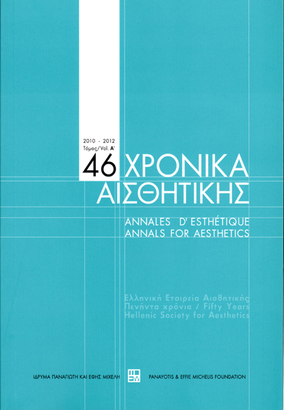Από το βάθος στην επιφάνεια : ευρωπαϊκή προοπτική και σύγχρονη ζωγραφική
Part of : Χρονικά αισθητικής : ετήσιον δελτίον της Ελληνικής Εταιρείας Αισθητικής ; Vol.Θ-Ι, 1970, pages 145-152
Issue:
Pages:
145-152
Parallel Title:
From the depth to the surface : perspective and modern painting
Abstract:
The sense of depth in painting found new expression on the discovery of central perspective which characterizes European painting from the Renaissance onward. This characteristic nevertheless disappears gradually after appearing with many variations until the end of the 19th century.The central perspective represents an achievement and at the same time a limitation in painting. As a creation of scientific observation and of rational thought this method depicts three-dimensional reality in the two-dimensional plane and through intellectual abstractionPainting gains clear spatial order. But at the same time is lost a great part of the essence of painting, consciously or not, the part which belongs in the indeterminate irrational field. The objectivity of the optical laws and the logical consequences of perspective (the Cyclopean eye, distortion and diminution) can be rationally understood but they do not cover the whole field of artistic perception; what is worse, they lessen spontaneity and directness of inspiration. All these reasons may contribute to the fact that perspective construction appears twice as an artistic means of expression in the history of European art : in Greek antiquity and in the Renaissance.Greek antiquity invented perspective but its characteristic is that it avoids using the central perspective, i.e. the use of one viewpoint. This is not a weakness of perception but a denial of acceptance of a single viewpoint implying an estrangement from the true nature of the objects of perception. Instead of one, the Greeks prefer several viewpoints, and in this way they attempt to save the individuality and the unity of form. The same attitude is found later in the Byzantine period as a purely Greek feature while the intervening Roman period approximates the characteristics of the later Renaissance.The three-dimensional character of the central perspective is no longer present in modern painting. Instead another characteristic, that of two-dimensionality, is the trend today, which reminds one of the nonperspective art. This abandonment of the European way ofseeing things becomes obvious in Cubism and other schools of painting in the first decade of the 20th century. This is the period when the European cultural tradition as well as European political power begins to lose its significance in the world. New factors have since appeared which have influenced the course of art and transposed the centre of cultural development and progression outside Europe.It is interesting to note that this specifically European way of perceiving the world developed in a period of great spititual and artistic activity when European political and cultural influence were universal. This particularly European mode of representation however is losing its significance just at the moment, when a progressive lessening of the Europe an influence is taking place.
Subject:
Subject (LC):




